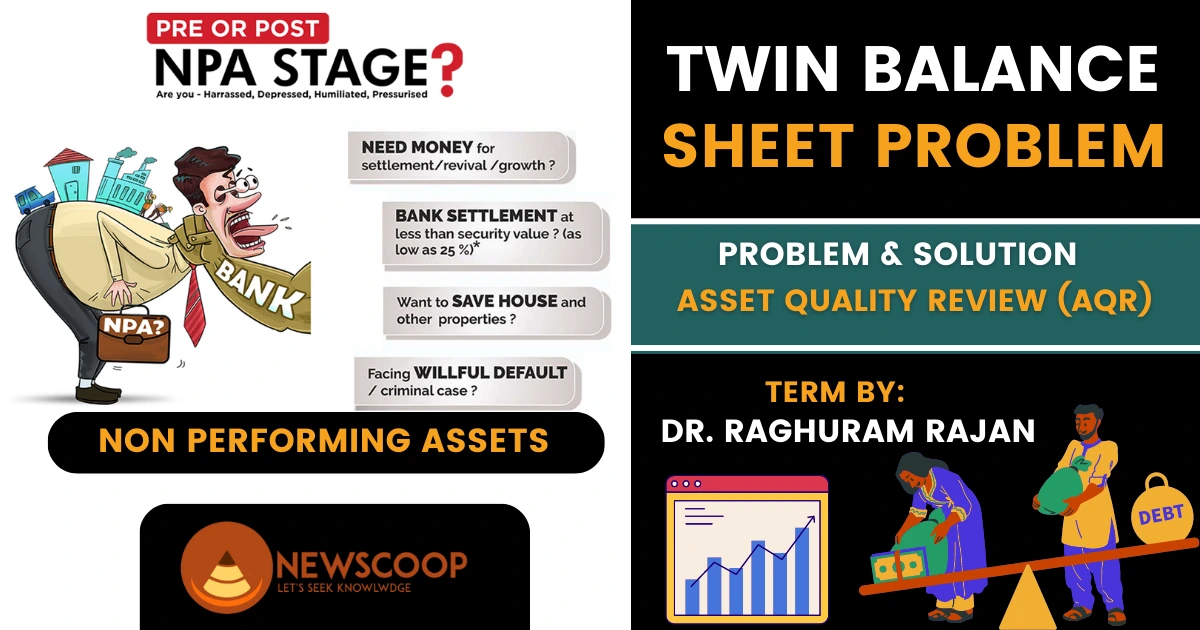In the realm of financial economics, the term “Twin Balance Sheet” has garnered significant attention in recent years. It refers to a situation where both the corporate sector and the banking sector of an economy face simultaneous balance sheet problems.
This phenomenon can have far-reaching implications for economic stability and growth. In this article, we will delve into the intricacies of the Twin Balance Sheet problem, its causes, effects, and potential solutions.
What is Twin Balance Sheet?
Twin Balance Sheet refers to the scenario where both the corporate sector and the banking sector of an economy are burdened with stressed or non-performing assets. It emerges when companies accumulate high levels of debt and struggle to service their obligations, while banks face an increasing number of non-performing loans.
| Aspect | Description |
|---|---|
| Definition | Twin Balance Sheet refers to a situation where both banks and corporations in an economy have weakened balance sheets simultaneously. |
| Problem | Banks have a high level of non-performing assets (NPAs) or bad loans, leading to capital erosion and reduced lending capacity. Corporations, especially in sectors such as infrastructure and power, have high levels of debt and poor profitability. |
| Causes | – Economic slowdown or downturn. |
| – Excessive lending by banks without proper risk assessment. | |
| – Over-leveraging by corporations for expansion projects. | |
| Impact | – Restricted credit availability for businesses. |
| – Decline in investment and economic growth. | |
| – Increased stress on the banking sector. | |
| Government Intervention | – Asset Quality Review (AQR) to identify and classify NPAs. |
| – Implementation of debt restructuring schemes for stressed companies. | |
| – Recapitalization of banks to strengthen their balance sheets. | |
| – Introduction of insolvency and bankruptcy laws for timely resolution of stressed assets. | |
| – Implementation of schemes like 5/25 refinancing and Sustainable Structuring of Stressed Assets (S4A). | |
| Challenges | – Identifying and quantifying the extent of NPAs accurately. |
| – Balancing the need for debt resolution with protecting the interests of lenders and borrowers. | |
| – Coordinating efforts among stakeholders to address the issue holistically. | |
| Global Examples | – India faced a Twin Balance Sheet problem in the late 2010s. The government implemented various measures like the Insolvency and Bankruptcy Code, AQR, and recapitalization to address the issue. |
| – Other countries, such as Japan in the 1990s and the United States during the 2008 financial crisis, also experienced similar challenges and implemented measures to resolve the Twin Balance Sheet problem. |
The Problem of Twin Balance Sheet
Let’s explore some of the key problems associated with the Twin Balance Sheet:
1. Stressed Corporate Balance Sheets
Companies burdened with high levels of debt and financial obligations face several difficulties, including:
- Debt Servicing Challenges: Corporates struggle to generate sufficient cash flows to service their debt, leading to defaults and financial distress.
- Reduced Investment Capacity: Stressed balance sheets limit companies’ ability to invest in new projects, research and development, and expansion, hindering economic growth and innovation.
- Negative Impact on Employment: Corporates facing financial difficulties may resort to cost-cutting measures, including layoffs, which can result in higher unemployment rates.
2. Non-Performing Loans in the Banking Sector
Banks grappling with a rising number of non-performing loans encounter various problems, including:
- Erosion of Capital Base: Non-performing loans erode banks’ capital reserves, reducing their ability to absorb losses and potentially leading to financial instability.
- Liquidity Issues: As non-performing loans increase, banks face challenges in maintaining adequate liquidity levels, affecting their ability to meet depositors’ demands and extend credit to viable borrowers.
- Credit Crunch: Banks, burdened with non-performing loans, become cautious in lending, leading to a reduction in credit availability for businesses and individuals, which further stifles economic growth.
3. Systemic Risks and Financial Instability
The Twin Balance Sheet problem can pose systemic risks to the entire financial system and create financial instability:
- Contagion Effect: Problems in the banking sector can spread to other financial institutions, causing a domino effect and potentially leading to a financial crisis.
- Investor Confidence: Twin Balance Sheet issues erode investor confidence in both the corporate and banking sectors, leading to capital outflows, reduced investments, and further economic downturn.
- Negative Feedback Loop: The interdependence between the corporate and banking sectors can create a negative feedback loop, where the problems of one sector exacerbate the issues in the other, intensifying the overall economic stress.

History of Twin Balance Sheet
The history of the Twin Balance Sheet problem can be traced back to the period of rapid economic growth in India, particularly between 2004 and 2011. During this time, Indian banks and corporations experienced a surge in lending and investment activities.
Banks were aggressively lending to fuel the expanding economy, and corporations were taking advantage of the favorable business environment to undertake ambitious expansion plans. However, as the global financial crisis hit in 2008 and the Indian economy started to slow down, cracks in the system began to emerge.
By around 2011, it became apparent that many Indian corporations were struggling to service their debt obligations. Several factors contributed to this situation, including a slowdown in economic growth, delays in project approvals, policy uncertainties, and corruption scandals. These factors led to a decline in corporate profitability and cash flows, making it increasingly difficult for companies to repay their loans.
The mounting debt burden on corporations started to impact the banking sector. Banks’ asset quality began to deteriorate as the loans extended to corporations turned into non-performing assets (NPAs). NPAs are loans on which borrowers have failed to make timely interest or principal repayments. As the number of NPAs increased, banks faced the challenge of maintaining sufficient capital reserves to cover potential losses.
Furthermore, the high level of stressed assets on banks’ balance sheets reduced their ability to extend credit to other borrowers. This created a credit crunch, inhibiting investment, and economic growth. The vicious cycle of stressed assets in banks and overleveraged corporations became the Twin Balance Sheet problem.
The issue gained significant attention in 2014 when Dr. Raghuram Rajan, the then Governor of the Reserve Bank of India, highlighted it in his speech. He termed it the “Twin Balance Sheet” problem, emphasizing the dual challenges faced by banks and corporations.
Following Dr. Rajan’s speech, efforts were made to address the problem. The government and the Reserve Bank of India initiated various measures to improve the health of both banks and corporations. These included the Asset Quality Review (AQR) to identify and recognize stressed assets, recapitalization of banks to strengthen their balance sheets, the introduction of the Insolvency and Bankruptcy Code (IBC) for timely resolution of stressed companies, and banking sector reforms to enhance supervision and governance.
It is important to note that the Twin Balance Sheet problem is a complex issue, and its resolution has been an ongoing process. The government and regulators continue to implement reforms and policies to address the underlying causes and restore the health of the banking and corporate sectors.
How to Solve Twin Balance Sheet Problem?
To solve the Twin Balance Sheet problem, several strategies and initiatives have been implemented. Here are some key measures that have been utilized:
1. Asset Quality Review (AQR)
- Conduct a comprehensive AQR to identify non-performing assets (NPAs) accurately and assess the overall health of the banking sector.
- This helps in quantifying the extent of the problem and enables targeted measures for resolution.
2. 5/25 Refinancing of Infrastructure Scheme
- Introduce refinancing schemes like the 5/25 scheme, where the repayment period for long-term infrastructure projects is extended to match the cash flow generation of the project.
- This provides relief to stressed infrastructure projects and ensures their long-term viability.
3. Sustainable Structuring of Stressed Assets (S4A)
- Implement the S4A scheme, which allows for the sustainable restructuring of stressed assets.
- Under this scheme, viable stressed assets are identified, and their debt is restructured, typically by converting a portion of debt into equity or optionally convertible debentures.
- This helps in reducing the debt burden and aligning it with the project’s cash flow.
4. Private Asset Reconstruction Companies (ARCs)
- Encourage the establishment and participation of private Asset Reconstruction Companies (ARCs).
- ARCs acquire distressed assets from banks and work toward their resolution or recovery.
- This helps in transferring NPAs from banks’ balance sheets and facilitates their resolution by specialized entities.
5. Strategic Debt Restructuring (SDR)
- Implement the SDR scheme, allowing lenders to convert debt into equity and take control of stressed companies.
- This enables lenders to restructure the management and operations of stressed companies to turn them around.
6. Bankruptcy and Insolvency Code
- Introduce or strengthen bankruptcy and insolvency laws to expedite the resolution process for stressed assets.
- Establish dedicated tribunals and time-bound resolution mechanisms to facilitate the efficient resolution of cases.
7. Capital Infusion
- Recapitalize banks to strengthen their capital base and enhance their ability to absorb losses from NPAs.
- Governments infuse funds into banks or facilitate their capital raising through various means.
8. Prompt Corrective Action (PCA) Framework
- Implement a PCA framework to monitor and supervise banks with high levels of NPAs and weak financials.
- This ensures that corrective measures are taken promptly to prevent further deterioration of banks’ financial health.
9. Enhancing Governance and Risk Management
- Strengthen governance practices within banks and financial institutions.
- Improve risk management frameworks, including credit appraisal, loan monitoring, and early warning systems.
10. Insolvency Professionals
- Develop a pool of qualified insolvency professionals to handle the resolution process efficiently.
- Establish training and certification programs to enhance their expertise in managing distressed assets.
11. Collaborative Approach
- Foster collaboration between banks, corporates, regulators, and government agencies to develop a coordinated approach.
- Promote information sharing and dialogue to address challenges collectively.
These measures, among others, aim to address the Twin Balance Sheet problem by resolving stressed assets, strengthening the banking sector, and promoting a conducive environment for economic growth. The effectiveness of these initiatives depends on their proper implementation, continuous monitoring, and adaptability to changing market dynamics.
Conclusion
The Twin Balance Sheet problem poses a significant challenge to economic stability and growth. By understanding its causes, implications, and potential solutions, policymakers, regulators, and market participants can collaborate to address the issue effectively.
Resolving Twin Balance Sheet challenges requires a comprehensive approach encompassing debt restructuring, banking sector reforms, policy initiatives, and macroeconomic support. By doing so, economies can strive towards sustainable growth, financial stability, and a healthier balance between corporations and banks.
Thank You!





